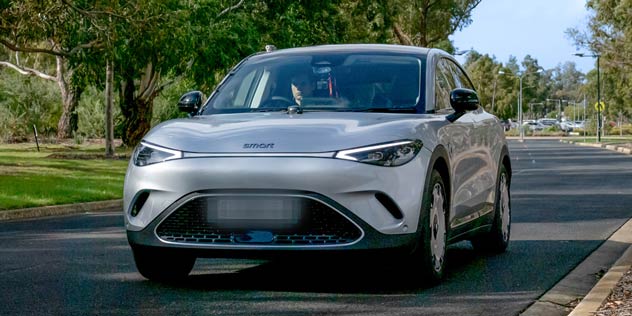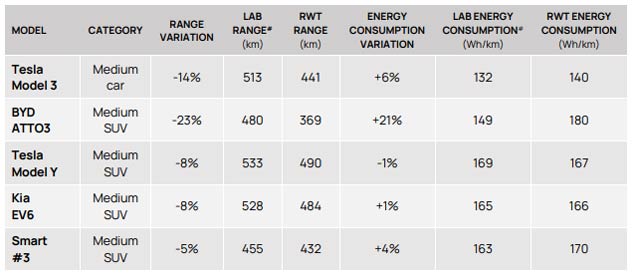
Electric vehicles are now under the magnifying glass of the Real World Testing Program , which aims to give drivers more understanding of how much fuel their cars actually use – or in the case of EVs, how much range they actually offer, in an effort to reduce so-called “range anxiety” in Australia.
In the first testing round of battery electric vehicles (BEVs), the AAA (Australian Automobile Association) tested five models and found that all of them cannot drive as far as official figures claim. The tests are all conducted on the same circuit which includes a mix of rural and urban roads and a motorway.
Meanwhile, the latest round of petrol, diesel, and hybrid testing revealed that 11 out of 30 internal combustion engine (ICE) and hybrid models used at least 10 per cent more fuel than advertised in real-world conditions – with the Hyundai Kona Hybrid consuming a staggering 33 per cent more than its lab-tested figure.

The models the AAA tested in the first round of BEVs were the Tesla Model 3 RWD, the Tesla Model Y Long Range, the BYD Atto 3 Extended Range, the Kia EV6 Air and the Smart #3 Premium. The actual driving range achieved in the real world tests was between 5 per cent and 14 per cent less than official figures, with the Model 3 coming in with 72km less range than its claimed 513km.
The BYD Atto 3 was next in line, achieving 12 per cent less (51km) than the WLTP rating of 420km as stated on its website. The Tesla Model Y achieved 43km than its claimed 533km range, the Kia EV6 drove 44km less than its 528km claimed range and the Smart #3 did the best, driving just 23km less than its 455km claimed range.
— Michael Bradley, AAA Managing Director
Important to note is that according to official figures released by the AAA, the BYD Atto 3 fared the worst with a 23 per cent gap under the range shown on the fuel efficiency sticker that is found on the windscreen of a new car.
However, this is because the AAA tests use figures submitted by carmakers. In the case of BYD, it has used figures are based on legislated Australian Design Rules (ADR) 81/02 tests (often equated to outdated NEDC testing procedures), which typically result in range figures that are far longer than the vehicle can achieve. A spokesperson for BYD confirmed to Open Road that it lists its WLTP figures on its website, and said, "The new ADR 81/03 revision will allow us to use WLTP figures for vehicles manufactured on and after 1st December 2026."
Other carmakers tested have chosen to display a shorter distance on the windscreen sticker in the form of WLTP ratings – which are more realistic but still fall short of real-world range. The differing results highlight the potential confusion for drivers looking to buy an EV.

The same issue arises when testing ICE and hybrid vehicles, with figures submitted by carmakers typically understating actual fuel use in real world conditions.
The results of the first round of BEV tests comes off the back of the latest round of ICE and hybrid tests.
Of the 30 vehicles tested in the latest tranche, 11 used at least 10 per cent more fuel on the road than their official lab figures. The 2024 Hyundai Kona Hybrid showed the biggest gap, consuming 33 per cent more fuel in real-world driving. It was followed by the 2025 Kia Stonic S (26 per cent more), 2024 Hyundai i30 Hybrid (17 per cent more), 2024 Toyota Fortuner GXL (16 per cent), and the 2025 Kia Sportage Hybrid SX (14 per cent).
Several vehicles were also found to exceed Australian lab tests regulatory limits of several gases, including the nitrogen oxide levels (a noxious gas that causes significant respiratory health issues) of the 2025 Ford Ranger 4x4, 2024 Toyota Fortuna GXL, 2024 Toyota Hi-Ace (LWB and SLWB) and 2025 BMW X1 sDrive18i. Additionally, the carbon monoxide levels of the Suzuki Vitara Turbo sat at 1178mg/km according to the testing procedures, for which the regulatory limit is 1000mg/km.
The AAA’s latest findings come ahead of new emissions rules set to take effect from 1 December 2025, when Euro 6 standards (in essence a stricter testing procedure) will become mandatory for all new models. Existing vehicle models will be granted a phase-in period until 1 July 2028, meaning some higher-polluting models could remain on sale for three years beyond this year.
Full testing results can be found at the Real World Testing Program website .
#Energy consumption and electric range figures quoted are reported in accordance with the Australian Government’s regulated standard, Australian Design Rule 81/02, and published on the Australian Government’s Green Vehicle Guide (greenvehicleguide.gov.au)